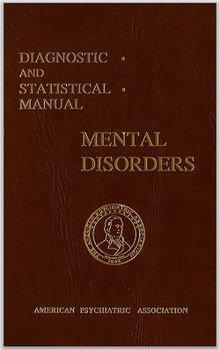
Back Diagnostiese en Statistiese Handleiding van Geestesteurings Afrikaans الدليل التشخيصي والإحصائي للاضطرابات النفسية Arabic Psixi pozğunluqların diaqnostik və statistik təlimatı Azerbaijani Диагностичен и статистически наръчник на психичните разстройства Bulgarian DSM Catalan Diagnostický a statistický manuál duševních poruch Czech Diagnostic and Statistical Manual of Mental Disorders Danish Diagnostic and Statistical Manual of Mental Disorders German Διαγνωστικό και Στατιστικό Εγχειρίδιο Ψυχικών Διαταραχών Greek Diagnoza kaj Statistika Manlibro de Mensaj Malordoj Esperanto

The Diagnostic and Statistical Manual of Mental Disorders (DSM; latest edition: DSM-5-TR, published in March 2022)[1] is a publication by the American Psychiatric Association (APA) for the classification of mental disorders using a common language and standard criteria. It is an internationally accepted manual on the diagnosis and treatment of mental disorders, though it may be used in conjunction with other documents. Other commonly used principal guides of psychiatry include the International Classification of Diseases (ICD), Chinese Classification of Mental Disorders (CCMD), and the Psychodynamic Diagnostic Manual. However, not all providers rely on the DSM-5 as a guide, since the ICD's mental disorder diagnoses are used around the world,[2] and scientific studies often measure changes in symptom scale scores rather than changes in DSM-5 criteria to determine the real-world effects of mental health interventions.[3][4][5][6]
It is used by researchers, psychiatric drug regulation agencies, health insurance companies, pharmaceutical companies, the legal system, and policymakers. Some mental health professionals use the manual to determine and help communicate a patient's diagnosis after an evaluation. Hospitals, clinics, and insurance companies in the United States may require a DSM diagnosis for all patients with mental disorders. Health-care researchers use the DSM to categorize patients for research purposes.
The DSM evolved from systems for collecting census and psychiatric hospital statistics, as well as from a United States Army manual. Revisions since its first publication in 1952 have incrementally added to the total number of mental disorders, while removing those no longer considered to be mental disorders.
Recent editions of the DSM have received praise for standardizing psychiatric diagnosis grounded in empirical evidence, as opposed to the theory-bound nosology (the branch of medical science that deals with the classification of diseases) used in DSM-III.[citation needed] However, it has also generated controversy and criticism, including ongoing questions concerning the reliability and validity of many diagnoses; the use of arbitrary dividing lines between mental illness and "normality"; possible cultural bias; and the medicalization of human distress.[7][8][9][10][11] The APA itself has published that the inter-rater reliability is low for many disorders in the DSM-5, including major depressive disorder and generalized anxiety disorder.[12]
- ^ DSM-5 (PDF). Retrieved January 10, 2022 – via Archive.Today.[page needed][full citation needed]
- ^ First M, Rebello T, Keeley J, et al. (June 2018). "Do mental health professionals use diagnostic classifications the way we think they do? A global survey". World Psychiatry. 17 (2): 187–195. doi:10.1002/wps.20525. PMC 5980454. PMID 29856559.
- ^ Cipriani A, Furukawa TA, Salanti G, et al. (April 7, 2018). "Comparative efficacy and acceptability of 21 antidepressant drugs for the acute treatment of adults with major depressive disorder: a systematic review and network meta-analysis". The Lancet. 391 (10128): 1357–1366. doi:10.1016/S0140-6736(17)32802-7. PMC 5889788. PMID 29477251.
- ^ Bandelow B, Reitt M, Röver C, et al. (July 2015). "Efficacy of treatments for anxiety disorders: a meta-analysis". International Clinical Psychopharmacology. 30 (4): 183–192. doi:10.1097/YIC.0000000000000078. PMID 25932596.
- ^ Schneider-Thoma J, Chalkou K, Dörries C, et al. (February 26, 2022). "Comparative efficacy and tolerability of 32 oral and long-acting injectable antipsychotics for the maintenance treatment of adults with schizophrenia: a systematic review and network meta-analysis". Lancet. 399 (10327): 824–836. doi:10.1016/S0140-6736(21)01997-8. PMID 35219395.
- ^ Gartlehner G, Crotty K, Kennedy S, et al. (October 2021). "Pharmacological Treatments for Borderline Personality Disorder: A Systematic Review and Meta-Analysis". CNS Drugs. 35 (10): 1053–1067. doi:10.1007/s40263-021-00855-4. PMC 8478737. PMID 34495494.
- ^ Frances, Allen (May 17, 2013). "The New Crisis in Confidence in Psychiatric Diagnosis". Annals of Internal Medicine. 159 (3): 221–222. doi:10.7326/0003-4819-159-3-201308060-00655. PMID 23685989.
- ^ Dalal PK, Sivakumar T (2009). "Moving towards ICD-11 and DSM-V: Concept and evolution of psychiatric classification". Indian Journal of Psychiatry. 51 (4): 310–319. doi:10.4103/0019-5545.58302. PMC 2802383. PMID 20048461.
- ^ Kendell R, Jablensky A (January 2003). "Distinguishing between the validity and utility of psychiatric diagnoses". The American Journal of Psychiatry. 160 (1): 4–12. doi:10.1176/appi.ajp.160.1.4. PMID 12505793.
- ^ Baca-Garcia E, Perez-Rodriguez MM, Basurte-Villamor I, et al. (March 2007). "Diagnostic stability of psychiatric disorders in clinical practice". The British Journal of Psychiatry. 190 (3): 210–216. doi:10.1192/bjp.bp.106.024026. PMID 17329740.
- ^ Pincus HA, Zarin DA, First M (December 1998). "'Clinical significance' and DSM-IV". Archives of General Psychiatry. 55 (12): 1145, author reply 1147–1145, author reply 1148. doi:10.1001/archpsyc.55.12.1145. PMID 9862559.
- ^ Regier D, Narrow W, Clarke D, et al. (2013). "DSM-5 Field Trials in the United States and Canada, Part II: Test-Retest Reliability of Selected Categorical Diagnoses". American Journal of Psychiatry. 170 (1): 59–70. doi:10.1176/appi.ajp.2012.12070999. PMID 23111466.